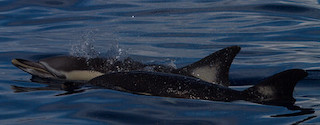 Watch out for schools of splashing and leaping Common Dolphins round the Lizard.
Watch out for schools of splashing and leaping Common Dolphins round the Lizard.
Photo: © Natural England / Rebecca Walker
Scientific name: Delphinus delphis
Other common names: Short-beaked Common Dolphin, Criss-cross Dolphin, Hourglass Dolphin, Saddleback Dolphin, Cape Dolphin, White-bellied Porpoise
Cornish name: The general word for dolphin is morhogh
Conservation status: IUCN Red List, Least Concern; In the UK protected under the Wildlife and Countryside Act, 1981, and the Wildlife (Northern Ireland) Order, 1985; UK Biodiversity Action Plan, priority species.
What to look for:
- Appearance: Grey, slender body with pale yellowish colouring on the lower flanks in an hourglass pattern. The slender beak is up to 12 cm long.
- Size: 1.6 to 2.6 m long
- Where: Widespread in temperate seas. In the UK, Common Dolphins are most often sighted around the south-west and western coasts, with the Lizard and Land’s End being good spots to see them in Cornwall.
- When: All year
- Similar species: Striped and Bottlenose Dolphins, but the hourglass-shaped pattern on the flank of the Common Dolphin is distinctive. Short-beaked and Long-beaked (D. capensis) Common Dolphins were only confirmed as separate species in 1994. It is the former we see round the Cornish coast.
 Everyone loves to see a school of dolphins leaping out of the water, creating a splash as they race through the sea or playfully following and even bowriding close to boats. They are very active and can move fast – at up to 60 km per hour – and would make noisy neighbours: a school can sometimes be heard from a few miles away across the water. This isn’t surprising given that this is a highly sociable mammal, living in mixed-sex groups of up to several hundred individuals, which may all be leaping and splashing at the same time.
Everyone loves to see a school of dolphins leaping out of the water, creating a splash as they race through the sea or playfully following and even bowriding close to boats. They are very active and can move fast – at up to 60 km per hour – and would make noisy neighbours: a school can sometimes be heard from a few miles away across the water. This isn’t surprising given that this is a highly sociable mammal, living in mixed-sex groups of up to several hundred individuals, which may all be leaping and splashing at the same time.
Common Dolphins can dive up to 280 m and for as long as eight minutes while hunting for their food of small fish and squid, working co-operatively to ‘herd’ and surround shoals of fish to make them easier to catch. Watch some of the short videos on the BBC Wildlife webpages (see references below) to observe this behaviour.
Dolphin species detect shoals using echolocation: we’re all familiar with the clicking noises they make – their sonar – but many of these clicks are outside the range of the human ear, so we are only hearing a small proportion of the noises a dolphin can make. Click here for a helpful explanation of how exactly this sonar ability works. Why have dolphins evolved to use sonar? Sound waves travel much more efficiently in water than in the air, so it is a better way of ‘seeing’ under the ocean surface, where conditions can often be murky or dark.
Female Common Dolphins mature at between six and nine years of age, and then give birth to a single calf every one to three years, after a ten-month gestation; the young dolphins are weaned no earlier than 19 months later. The entire school is very protective of its young. They are also of course protective of injured school companions, and have been observed lifting them to the surface to breathe.
Although a relatively common marine mammal species, there are several threats for both species of Common Dolphins and dolphins in general, including entanglement in fishing nets (purse-seine and drift-net fisheries are the main factor), marine pollution (considered a particular problem in the Mediterranean), noise disturbance (a factor that has been associated with some mass strandings), and loss of food sources due to competition with commercial fisheries.
Did you know…?
…’Breaching’ is the word used to describe dolphins leaping out of the water; ‘lobtailing’ describes the behaviour of slapping down their flippers on top of the water.
…The UK’s largest mass stranding of Common Dolphins occurred in 2008, in Falmouth Bay. It is thought the most likely cause was acoustic disturbance from international naval exercises in the area
…Bilingual? Delphinus is the Latin and delphis the Greek for dolphin.

More information and references:
Groves, D., 2013. The Mammals of Cornwall and the Isles of Scilly. Cornwall Mammal Group. ERCCIS, Truro, Cornwall.
Jepson, P.D. et al., 2013. What caused the UK’s largest Common Dolphin (Delphinus delphis) mass stranding event? PLOS One, DOI: 10.1371/journal.pone.0060953.
Macdonald, D. and Barrett, P., 1993. Collins Field Guide: Mammals of Britain and Europe. HarperCollins, London.
Published: July 2014
Author: Amanda Scott
Photos: © Natural England / Rebecca Walker
